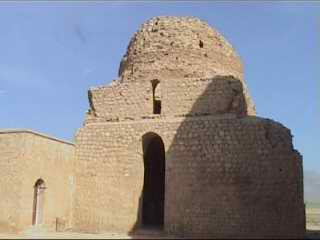Sarvestan Palace on:
[Wikipedia]
[Google]
[Amazon]


 The Sassanid Palace at Sarvestan ( fa, کاخ ساسانی سروستان ''kakh-eh Sassani-ye Sarvestan'') is a
The Sassanid Palace at Sarvestan ( fa, کاخ ساسانی سروستان ''kakh-eh Sassani-ye Sarvestan'') is a


 The Sassanid Palace at Sarvestan ( fa, کاخ ساسانی سروستان ''kakh-eh Sassani-ye Sarvestan'') is a
The Sassanid Palace at Sarvestan ( fa, کاخ ساسانی سروستان ''kakh-eh Sassani-ye Sarvestan'') is a Sassanid
The Sasanian () or Sassanid Empire, officially known as the Empire of Iranians (, ) and also referred to by historians as the Neo-Persian Empire, was the last Iranian empire before the early Muslim conquests of the 7th-8th centuries AD. Named ...
-era building in the Iran
Iran, officially the Islamic Republic of Iran, and also called Persia, is a country located in Western Asia. It is bordered by Iraq and Turkey to the west, by Azerbaijan and Armenia to the northwest, by the Caspian Sea and Turkmeni ...
ian city of Sarvestan, some 90 km southeast from the city of Shiraz
Shiraz (; fa, شیراز, Širâz ) is the fifth-most-populous city of Iran and the capital of Fars Province, which has been historically known as Pars () and Persis. As of the 2016 national census, the population of the city was 1,565,572 p ...
. The palace was built in the 5th century AD, and was either a gubernatorial residence or a Zoroastrian
Zoroastrianism is an Iranian religion and one of the world's oldest organized faiths, based on the teachings of the Iranian-speaking prophet Zoroaster. It has a dualistic cosmology of good and evil within the framework of a monotheistic ...
fire temple.
History
The Sarvestan Palace was built by the Sasanian king Bahramgur ( fa, بهرام گور) (r. 420–438), and dominates an immense, empty plain. The name "palace" is a bit misleading, because the monument's function is not really understood. It may in fact have been a hunting lodge or even a sanctuary. The problem is complicated by the fact that there appears to have been a small building, just north of the palace; its function is unknown.Palace court
A visitor who would have arrived from the south, would have seen threeiwan
An iwan ( fa, ایوان , ar, إيوان , also spelled ivan) is a rectangular hall or space, usually vaulted, walled on three sides, with one end entirely open. The formal gateway to the iwan is called , a Persian term for a portal projecting ...
s. After entering the central one, he would have reached a large square hall under a large dome, made of baked brick. After this, a visitor would have found himself on a rectangular courtyard, surrounded by the residential quarters. The building reminds one of the Ghal'eh Dokhtar and the palace of Ardashir Ardeshir or Ardashir ( Persian: اردشیر; also spelled as Ardasher) is a Persian name popular in Iran and other Persian-speaking countries. Ardashir is the New Persian form of the Middle Persian name , which is ultimately from Old Iranian ''*Ar ...
, both near Firuzabad; the difference is that the Sarvestan palace is open to all sides. The building, made of stone and mortar, must have had fine decorations, which partly survive.
See also
*Iranian architecture
Iranian architecture or Persian architecture ( Persian: معمارى ایرانی, ''Memāri e Irāni'') is the architecture of Iran and parts of the rest of West Asia, the Caucasus and Central Asia. Its history dates back to at least 5,000 BC ...
* History of Persian domes
References
* J Homayooni (1996), ''History of Sarvestan''. {{castle-stub Architecture in Iran Sarvestan Castles in Iran Sasanian castles Buildings and structures in Fars Province Historic buildings and structures in Iran Sasanian palaces